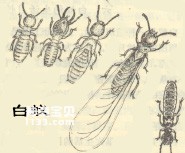[Economic Significance] Isoptera is a type of social insect with gregarious nesting habits and complex hierarchical differentiation. Because of its interesting habits and outstanding economic significance, it has attracted people's attention very early. Termites are the enemy of agriculture, forestry, water conservancy projects, houses and buildings, stored materials, etc. Its harm is destructive, hidden and widespread. There is a folk song like this: Tiny termites, with bodies like glutinous rice, not to mention not big, with copper heads and iron mouths. When passing through a mountain path, water will penetrate the bottom. If you ask about the danger, it will be a mile and a half. Characteristics of moth erosion include paper, cloth, beam-framed furniture, and wood fibers, endangering houses and threatening dams.

[Identification characteristics] Because the size and shape of the front and rear wings are equal, it is named Isoptera. The adults resemble ants, but are fat and especially colorless, so they are also called termites, for short. Body length is generally 3.5-6 mm. Antennae bead-shaped. Chewing mouthparts. Winged termites shed their wings after their nuptial flight, leaving only their wing scales. There are 10 abdominal segments, there are tail whiskers, and the external genitalia is not obvious.
The difference between termites and ants
|
Name |
Termites |
Ant |
|
Classification status |
Isoptera |
Hymenoptera |
|
perverted type |
Incomplete metamorphosis (eggs, nymphs, adults) |
Complete metamorphosis (egg, larva, pupa, adult) |
|
body shape |
Head, chest and abdomen are almost equal |
There is an obvious thin waist at the junction of head, chest and abdomen. |
|
body color |
Milky white, brown, light yellow, yellow |
Black, yellow, brown red |
|
wing |
The forewings and hind wings of winged adults are equal in length and lie flat on the back. The wing veins are thin, numerous and thick-line-shaped. |
The forewings of the winged adults are larger than the hind wings, the wing veins are few and thick, and the color is obvious. |
|
Activity pattern |
Worker ants and soldier ants are photophobic and hide underground. |
Most are not afraid of light. |
|
feeding habits |
Monophagous, feeding on wood, crops, grass roots and other fiber materials. |
Omnivorous, likes fishy and sweet food. |
|
excrement |
Compact and chunky, fine-grained and strong. |
Loose and fine grained. |
[Species and Distribution] There are more than 3,000 known species in the world, most of which live in the tropics. There are more than 400 species of termites in my country. For the hierarchical differentiation and habits of termites, please refer to "Strictly Hierarchical Social Life - Termites". For its hazards and prevention, please see "Experts in Digging Building Walls".
The characteristics of this order can be summarized as follows: nesting termites of the order Isoptera, with four wings with the same horns; worker ants and soldier ants as breeding ants, which fly off their wings after marriage and inhabit the soil.
animal tags: Insects Isoptera Termites
We created this article in conjunction with AI technology, then made sure it was fact-checked and edited by a Animals Top editor.